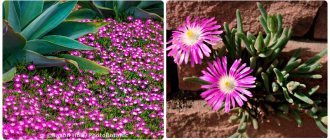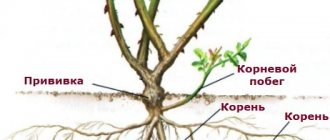History of the variety's creation
Rose Jazz was bred in 2003 in the German nursery Tantau. The full name of the variety is That's jazz. Despite its short period of existence, this climbing plant has won the hearts of hundreds of gardeners. In addition, the ground cover rose Jazz has become a prize-winner at many flower festivals and competitions.
Rose Jazz is one of the most famous ground cover flowering crops
Application in landscape design
The plants are great for creating beautiful floral displays in your lawn. They are also used as decoration for flower beds or paths, where plants with a neat and compact flowering pattern are best suited.
This type of rose is planted in rose gardens near other plants to create various compositions. You can often find low-growing roses that are planted near stones. Later, a beautiful rock garden appears.
Creeping roses will fit well into the interior of stone buildings and multi-level gardens. Also, ground cover varieties can be planted in flowerpots, hanging baskets, and used to decorate walls. The characteristics of low-growing roses are used with pleasure by professional landscape designers and amateur gardeners.
Description and characteristics of the Jazz rose
The crop is a shrub covered with many small flowers. The height of the bush, as a rule, does not exceed 70 cm, and the diameter is 50 cm. The plant blooms for a very long time, almost without interruption. The number of flowers is huge: up to 10 buds are formed on one stem, the diameter of which reaches 4 cm. The flowers of the ground cover rose Jazz are semi-double. At the moment of blooming, the flowers are orange in color, but as they open, the buds acquire a soft peach hue.
Despite its high decorative properties, the crop is characterized by excellent frost resistance. The plant easily tolerates prolonged rainfall and quickly recovers after frost. In addition, the Jazz rose is resistant to various types of fungal diseases.
As the buds open, they acquire a soft peach hue.
Plant care
In order for the plant to develop well and look as attractive as possible, you need to adhere to certain rules when growing it.
Watering rules and humidity
Rose Pilgrim (The Pilgrim) - characteristics of the varietal shrub
Once a week, the bushes should be watered at the root. It is recommended to perform the procedure early in the morning and use warm water. During drought, the amount of watering is reduced.
Fertilizing and soil quality
The variety is characterized by rapid growth, and therefore it needs to be systematically fed. In this case, you should adhere to the following scheme:
- in early spring, apply nitrogen agents;
- then use formulations based on potassium and sodium;
- Finally, phosphorus fertilization is carried out.
Pruning and replanting
It is not recommended to prune roses frequently. In the first year, it is enough to lightly trim the ends of the shoots. Then you should remove dry branches and thin out slightly to maintain shape. It is important to maintain a distance of 1 cm from the kidney.
Note! To avoid infection, the cuts must be treated with garden varnish.
Features of wintering a flower
The variety is highly resistant to frost. It can be easily grown in the Moscow region without shelter. Even if the shoots freeze slightly, the plant quickly recovers.
Advantages and disadvantages of the variety
Based on the description of the variety, the following conclusions can be drawn about the advantages of the variety:
- long flowering period;
- resistance to pests and fungal diseases;
- winter hardiness and resistance to excessive soil moisture;
- comparative ease of care;
- no need for regular pruning;
- the ability to self-get rid of faded buds;
- Widely used in landscape design.
However, this variety of rose also has disadvantages. The main ones include:
- susceptibility to fungal diseases in case of non-compliance with the watering regime;
- the presence of sharp thorns that complicate the process of tying and trimming;
- slow growth of the crop in shady areas.
Common mistakes rose growers make
- As you know, under the scorching rays of the sun, roses quickly fade, the color of the buds fades, and the petals “burn.” For this reason, some gardeners plant rose gardens near the walls of buildings or under the spreading crowns of trees. This proximity protects roses from heat and wind . The main mistake of inexperienced gardeners is not maintaining an acceptable distance between rose bushes and large plants. Trees with a developed root system take away moisture and nutrients from roses. The stems weaken, become thinner, blind shoots form, and the risk of fungal diseases increases. The roots of roses planted closer than 0.5 m to concrete wall foundations freeze in winter.
- The indicator of soil moisture and the depth of groundwater are essential characteristics when choosing a location for setting up a rose garden. Excess moisture in the soil increases acidity, impedes the access of oxygen, and overcools the roots of the plant during wintering. In areas where there is stagnation of moisture, even for a short time, gravel or crushed stone laid at the bottom of the planting hole is indispensable. The drainage pad softens, but does not completely solve the problem of excessive soil moisture. To drain water from the roots of roses planted in a waterlogged area, it is necessary to lay drainage pipes.
Tip #1 : Roses will not suffer from stagnant melt water if you create a kind of podium for planting them, that is, raise the rose garden 50-60 cm above the general ground level.
Features of agricultural technology of the ground cover rose Jazz
One of the main advantages of the Jazz variety is its long flowering period. So, the first flowers appear on the bush in June, and the crop fades in mid-October. However, in order to enjoy the fragrant flowering of the shrub for so long, it is necessary to comply with certain standards of agricultural technology.
How and where to plant
To determine the most suitable landing site, it is important to consider the following rules:
- Groundwater. They must be at a depth of at least 100 cm from the roots of the bush. Otherwise, the root system may simply rot.
- Air circulation. Free air circulation is very important for ground cover roses. It prevents stagnation of liquid in the soil.
Lowlands or swampy areas are absolutely not suitable for planting. Here the plant may rot.
Roses are planted in mid-spring. In autumn, planting should be carried out in a short time, because there is a high risk that the plant will not take root. As for the composition of the soil, you should give preference to loamy or chernozem options - Rose Jazz loves soil with a low level of acidity.
The depth of the planting hole should be about 60 cm, and its diameter should be 70 cm. After the plant is placed in the hole, it is important to carefully straighten the roots. Once planting is complete, the crop is watered with warm water and mulched with a thick layer of peat.
It is worth considering that the planting site should not be in the open sun all day long. The most suitable place is considered to be partial shade. Otherwise, the plant may get sunburned and die.
Variety Jazz does not like active sunlight
How to care
The basic procedures for caring for the Jazz rose include weekly loosening, watering every 2-3 days and fertilizing. Watering should be done only after the top layer of soil is completely dry. One bush requires about 15 liters of water. It should first be heated in the sun. As autumn approaches, the frequency of watering is gradually reduced, and with the onset of September it stops completely.
Feeding is carried out twice a season. Nitrogen compounds are applied for the first time in early spring to stimulate crop growth. The second feeding is done in the summer, using potash and phosphorus fertilizers. They influence the formation of buds and maintain the plant’s immunity at a high level.
To stimulate budding, it is recommended to remove the first rose flowers. Thus, the next year the bush will be abundantly covered with flowers.
Author's advice
In the spring, sanitary pruning should be carried out, during which all damaged, dry shoots will be removed. In the fall, this procedure can be carried out again to thin out the bush a little.
Despite its resistance to cold weather, it is still recommended to cover the plant for the winter. Coniferous spruce branches are used as insulation, which is placed between the branches and on top of the bush. Gardeners who live in regions with cold winters often make special frames. They are covered with plastic bags, which provide reliable protection for the crop from wind and frost.
Watering mode
Feeding with mineral compounds
Spring pruning
Reproduction
Rose Chippendale - characteristics of the varietal shrub
If you want to have several bushes of the beautiful Jazz in the garden, then in early March the plant needs to root the shoots. To do this you need:
- Shallow long trenches are dug parallel to the bush.
- Straight shoots are selected.
- The shoots should be placed in trenches so that the outer buds are on the surface of the ground.
- The branches are attached with pins and covered with earth.
Note! One bud on the shoot must be in contact with the ground for the branch to take root.
Rose propagation
With regular watering, the roots of a young seedling quickly grow. Next spring, the new bush can be separated from the adult plant and planted in a permanent place.
The climbing rose Naheglut (That Jazz) is a variety that can decorate any garden, but for this you need to provide it with proper care (watering, loosening, fertilizing). The time and effort spent will definitely pay off: the cascades of flowing creamy apricot flowers are worthy of a painter’s brush. The music of blossoming Jazz cannot but arouse admiration.
Answers to flower growers' questions
Question #1: Is it necessary to mulch the soil under ground cover roses?
- cut grass (preferably mature);
- humus, peat or peat-compost mixture;
- last year's (by no means fresh) sawdust and shavings;
- conifer bark.
Tip #2: Rotted manure and bird droppings are not only useful organic fertilizer for roses, but also excellent mulch. The bushes are covered with such mulching material in early spring. Autumn application is not advisable so as not to overheat the plant’s root system.
Question No. 2: What partners are suitable for proximity to the Jazz rose?
Traditional neighbors of ground cover roses in group plantings in flowerbeds and mixborders:
Diseases, pests and ways to combat them
Sahara is quite resistant to various lesions, however, improper care and unsuitable conditions can lead to diseases of the root system and the entire bush.
Aphids and other pests also pose a danger. You can get rid of lesions using special antibacterial and antifungal agents. If desired, you can use folk recipes.
The Sahara rose is a beautiful plant that will fit perfectly into any landscape design. The bush does not require special care, suitable even for beginners. It is not difficult to propagate a flower, the main thing is to follow all the necessary rules.
Origin
Rose grandiflora (grandiflora)
The first of these is Just Joey (1972). Its author, Roger Posey, is the son of one of the owners of the company. Having crossed two CG roses - the famous Fragrant Cloud (Duftvolke) and the yellow fragrant 'Dr. AJ Verhage' (originator Gysbert Verbeek, 1963), he received a beautiful flower, devoid of any flaws.
The breeder decided to name the rose in honor of his wife, Joey Posey. However, considering that her name did not sound too melodious for such beauty, he asked her for advice. Not at all offended, the wife said: “Just call her Joey.” That’s how the rose came to be called “Just Joey – Just Joey.”
Description
The plant forms a well-branched lush bush with a height of 75 to 120 cm and a width of up to 120 cm. The leaves are leathery, glossy, dark green in color, and medium in size.
The rose is remontant and blooms profusely and for a long time. Elegant conical buds (8-10 cm), salmon-orange in color, gradually open into a huge double cup-shaped flower up to 15 cm in diameter. The ruffled petals are amber yellow with a copper tint, with a slight blush on the reverse side.
Unusually beautiful in any phase of dissolution, single flowers, only occasionally collected in a brush, have a strong, rich fruity aroma, reminiscent of the smell of melon and orange. Just Joey has enviable health, is resistant to powdery mildew and black spot and comes out of winter well. The flowers are very resistant to wet weather, and the buds bloom even after prolonged rains.
Agrotechnical features
Just Joey is designed for gardening in 7b to 10b USDA zones. But, according to the observations of flower growers, it develops better in cool climates: the flowers have a brighter color, and their aroma intensifies. In hot weather, they quickly fade, so you need to select a planting site taking this feature into account.
Otherwise, caring for the magnificent “Just Joey” is no different from the standard for roses of this group.
World recognition
Ideal beauty, unusual flower color, and endurance have made this rose very popular in the world. She has won prestigious awards at numerous competitions and exhibitions. It started with a rose testing certificate obtained in Hamilton (New Zealand) in 1975.
The James Mason 'Just Joey' Medal of Honor was awarded in 1986 by the Royal Rose Society of Great Britain. It is awarded to varieties of roses that have enjoyed particular success among gardeners over the past 20 years.
In 1993, the rose received the prize of the Royal Horticultural Society (AGM) as a plant recommended for cultivation in England.
In 1994, Just Joey took pride of place in the World Federation of Rose Societies (WFRS) Hall of Fame list as the world's favorite rose.
In 1999-2001, she was twice awarded the title of "Show Princess" and "Queen of Show" by the American Rose Society (ARS).
In 2001, the rose received an Honorary Prize at an exhibition in the USA from the Austin Rose Society. This is how she is “Simply Joey”, the rose is perfection itself: its flowers with a divine aroma, on long shoots, are equally charming both in a flowerbed in the garden and in the interior of a room.
Diseases
Does the rose have a gray-white coating or brown balls on the leaves? Methods to combat the disease. Powdery mildew
Black spots of a round shape have appeared on the leaves of the rose, what should I do, how can I save the plant? Black spot
The rose is sprinkled with yellow powder, the leaves and stems crack and die, how to get rid of the disease? Rust
Has a gray coating appeared on the rose? This is gray rot that needs to be gotten rid of as soon as possible. Gray rot
A rose will entwine an ugly pillar and turn it into a fabulous garden decoration. Rosanna can be planted near gazebos so that she can weave along their walls. The flower also looks good in separate rose gardens; the tall stems are intertwined with each other in the form of a solid green cap with bright roses.
Growing a flower: how to plant it correctly in open ground
The plant has excellent decorative properties. To achieve success in its cultivation, you need to carry out planting work correctly.
The plant is recommended to be propagated by seedlings. In order for the rose to grow normally and delight you with its decorative effect, it is best to buy planting material from trusted nurseries.
Important! The seed method is used only by breeders, since it does not allow preserving varietal characteristics. Experienced gardeners recommend planting the plant in late spring
This must be done after the soil has completely warmed up.
Experienced gardeners recommend planting the plant in late spring. This must be done after the soil has completely warmed up.
Selecting a location
A sunny area that is protected from the wind by other plants is suitable for planting. Roses need light and fertile soil.
How to prepare the soil and flower for planting
Before planting, the plant must be soaked in a growth stimulator. On the site you need to make a square hole measuring 60 by 60 cm. You also need to mix a mixture based on sand, clay, peat, humus, garden soil and make a hole in it. You can add superphosphate and ash.
Step by step landing procedure
To plant a plant you should do the following:
- Place the seedling in the hole and straighten its roots.
- Gradually sprinkle the rose with soil and compact the soil.
- Hill up the rose and fill the trunk circle with water.
- Sprinkle it with sawdust and dry bark.
Important! The plant should be watered moderately for several days. Otherwise, there is a risk of active development of above-ground shoots against the background of undeveloped roots
When planting, you need to observe a number of features
What do mixed bouquets or roses with a border mean?
Knowing what colors roses come in and what they symbolize, you can create not only a beautiful composition, but also put meaning into it, express your feelings and wishes through flowers. Any combination of shades looks beautiful. They are combined depending on the intended meaning. Scarlet and snow-white inflorescences are a sign of passionate, endless love, and snow-white and golden ones are a sign of purity of thoughts and admiration. Combinations of roses and flowers with edging, which are selected depending on what feelings you want to express or to whom the composition is presented:
- A combination of scarlet, fiery and sunny colors - the combination of these shades carries a powerful energy message that expresses admiration, love and immeasurable gratitude. Such mixes are suitable for wives with whom they have lived more than one year of happy life, and they will also be appropriate for bosses whose work evokes genuine respect.
- A combination of scarlet and snow-white - if there are more dark inflorescences, this is a manifestation of love. If there are more light ones, it is a symbol of gratitude and recognition.
- A snow-white bouquet with one scarlet rose – love and respect. If the composition is scarlet, and there is one light rose in it, this sign indicates that your beloved is one in a million.
Note! “I love you, I admire you, you are immensely beautiful” - these words can be expressed by a composition of delicate light inflorescences with a pink edging of the petals
A mix of roses in one composition is a great solution for expressing your feelings
Pests
Microscopic spiders have appeared on the plant, and the rose is gradually becoming covered with cobwebs, what should I do? Spider mite
Are small green insects destroying your rose? Effective methods of pest control. Green rose aphid
Caterpillars have appeared on the rose and are twisting the leaves of the plant, how to deal with the pest Rosen leaf roller
Flat bumps have appeared on the shoots of the rose or on the underside of the foliage, how to deal with the pest Rosen scale insect
Mole crickets have appeared in the garden, this is very dangerous for your flowers, find out how to drive away the pest Mole cricket
Several sources of foamy liquid have been observed on the rose bush; this is a dangerous pest.
- Frost resistance;
- Disease resistance;
- Decorative qualities;
- Unusual decoration of landscape design;
- Tall, powerful stems with abundant dark green foliage;
Flaws:
- Weak aroma;
- Does not tolerate rainy weather well;
- Not a compact shrub.











